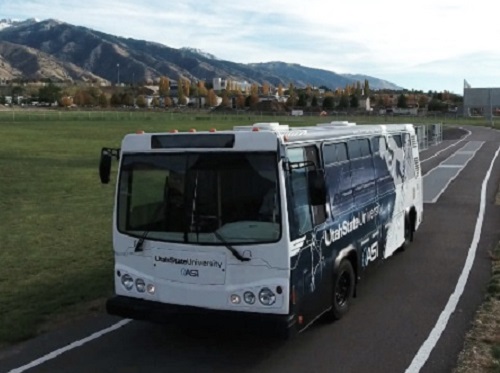The Utah Electrification of Transportation Infrastructure Steering Committee recently met for the first time; a group created by the state legislature to help guide Utah’s installation of infrastructure that is both sustainable and economical to spur the state’s transition to electric transport.
[Above photo by the Utah DOT]
“We’re at a tipping point for electrification of transportation,” explained Carlos Braceras, executive director of the Utah Department of Transportation and the committee’s chairman. “Our mission here is to help Utah residents live healthier lives by improving air quality while strengthening the economy.”
The state legislature’s bill that created the steering committee also provided $2.1 million to Utah State University’s Center for Advancing Sustainability through Powered Infrastructure for Roadway Electrification or “ASPIRE” to “lead the charge” in developing a community, state, and industry transportation action plan to improve air quality while enhancing the economy.
The Utah DOT noted in a statement that the ASPIRE Engineering Research Center – created in 2020 through a $25 million National Science Foundation grant, which is renewable to $50 million over 10 years – is forming an industry advisory board with representation across the industries, communities, and stakeholders affected by the shift to an electrified transportation system.
“We need tomorrow’s technologies to do this thing right,” said Dr. Regan Zane, director of ASPIRE, who also serves on the steering committee. “Now is the time to inject innovation into developing the future vision of our communities and transportation systems. This will inform critical decisions today on infrastructure investments to accelerate our path to clean air and a reduced cost to move people and goods.”
“The question we face now is how we transition to that electrified future,” added Utah DOT’s Braceras. “It’s a complicated process that requires careful planning and a coordinated approach across agencies, industries and communities to build a sustainable solution.”
State departments of transportation across the country are involved in a number of different efforts to help spur transportation system electrification.
For example, the Maryland Department of Transportation recently rolled out a new tool to help local governments and agencies dip into $2.5 billion in federal grants to build an electric vehicle or EV charging network.
The EV Charger Siting Tool is a map-based website that helps the user select those communities and charging sites in Maryland that have the best chance of securing grants under Federal Highway Administration’s Charging and Fueling Infrastructure or CFI discretionary grant program, funded by the $1.2 trillion Infrastructure Investment and Jobs Act or IIJA enacted in November 2021.
From a broader perspective, the North Carolina Department of Transportation recently released the finalized version of its North Carolina Clean Transportation Plan, outlining a roadmap to continue growing the state’s clean energy economy while reducing greenhouse gas or GHG emissions and investing in cleaner and more accessible transportation options for state residents.
The NCDOT said it worked with more than 220 stakeholders for more than a year to develop this draft plan – mandated by Governor Roy Cooper (D) via Executive Order 246 issued January 2022 – which explores strategies to advance clean transportation investments and workforce development statewide.
In a more targeted fashion, the Oregon Department of Transportation recently introduced a rebate plan for state residents living in multifamily homes as well as motorists near public parking areas to spur access to EV charging stations.
The Oregon DOT said the rebate offered by its new Community Charging Rebates Program will range from $4,250 to $5,500 per charging port or up to 75 percent of eligible project costs, whichever is less, to help lower the cost of buying, installing, and maintaining Level 2 and Level 1 EV charging stations.
The American Association of State Highway and Transportation Officials held a knowledge session at its 2022 Annual Meeting that featured panelists from the Michigan, Pennsylvania, and Florida DOTs discussing their respective plans for National Electric Vehicle Infrastructure or NEVI program funds – one part of their concerted efforts to help support transport electrification.
In September 2022, the Federal Highway Administration issued final approvals for the EV infrastructure deployment plans submitted by all 50 states, the District of Columbia, and Puerto Rico.
Those plan approvals allow all of those 52 transportation departments to unlock more than $900 million in fiscal year 2022 and 2023 NEVI funding.

